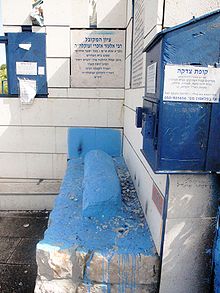Elazar ben Moshe Azikri
Elazar ben Moshe Azikri | |
|---|---|
 Rabbi Elazar Azikri's grave in Safed | |
| Personal life | |
| Born | 1533 |
| Died | 1600 |
| Religious life | |
| Religion | Judaism |
| Buried | Safed Old Jewish Cemetery |
Rabbi Elazar ben Moshe Azikri (Hebrew: אלעזר בן משה אזכרי) (1533–1600) was a Jewish kabbalist, poet and writer.
Biography
[edit]Azikri was born in Safed to a Sephardic family who had settled in Ottoman Syria after the expulsion of Jews from Spain. He studied Torah under Yosef Sagis, Jacob Berab, and in the yeshiva of Moses ben Jacob Cordovero.
He is counted with the greatest Rabbis and intellectuals of his time: Shlomo Halevi Alkabetz, Yosef Karo, Moshe Cordovero, Isaac Luria, and Israel ben Moses Najara, among others. He was one of a handful of rabbis to receive the renewed rabbinic semikhah initiated by Jacob Berab.[1]
In 1588 Rabbi Elazar founded the "Sukat Shalom" movement, which acted to arouse in Jews devotion to religion. His Sefer Haredim blends a halakhic enumeration of the 613 commandments with Kabbalist ethics and is one of the central works of its genre.[1]
Rabbi Elazar died in 1600 and was buried in Safed Old Jewish Cemetery.
Works
[edit]Rabbi Elazar's best known Book, the Sefer Haredim (Hebrew: ספר חרדים), is a famous discussion of the 613 commandments and is one of the main works of Jewish deontology. It was printed after his death in 1600. Its arrangement differs from other similar books:[2] First, the commandments are arranged according to the human body and/or the time on which they depend in their observance; second, the work does not maintain a single count of the commandments but rather lists these according to the opinion of several Rishonim.
He also wrote a commentary on Tractates Beitza[3] and Berakhot[4] of the Jerusalem Talmud.
The piyyut (liturgical poem) Yedid Nefesh is commonly attributed to Elazar, who first published it in the Sefer Haredim.
References
[edit]- ^ a b Elazar ben Moshe Azikri, sefaria.org
- ^ Sefer Chareidim by Rabeinu Elazar Azkari
- ^ "Dr. Israel Francus". Archived from the original on April 13, 2004. Retrieved 2007-08-26.
{{cite web}}: CS1 maint: bot: original URL status unknown (link). The commentary is reprinted in the Oz Vehadar edition of the Jerusalem Talmud. - ^ Printed in the Vilna Yerushalmi Brachot.
External links
[edit]- Biography - from the Orthodox Union
- Sefer Hareidim (Venice) – free scanned version in DjVu format
- Traditional Sephardi Singing of Yedid Nefesh


 French
French Deutsch
Deutsch